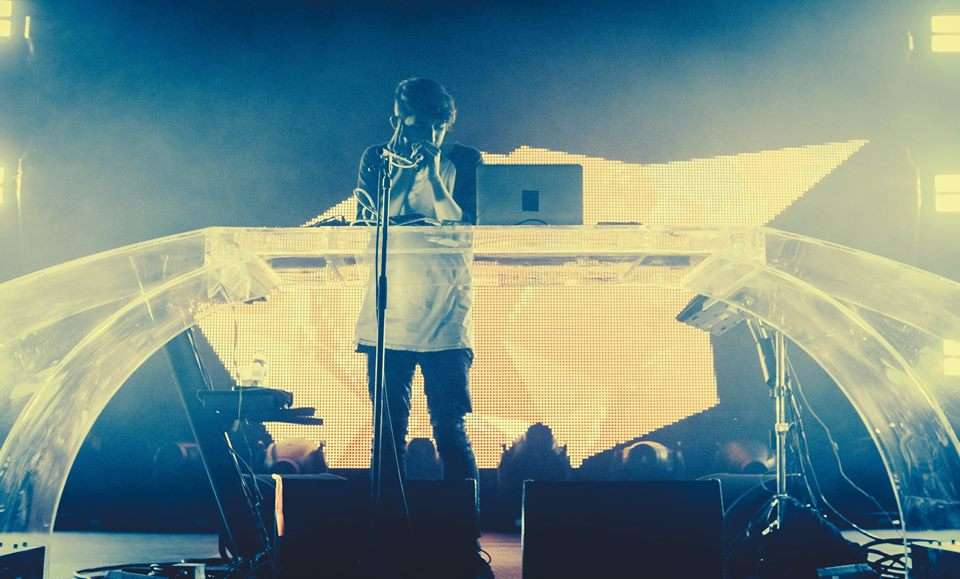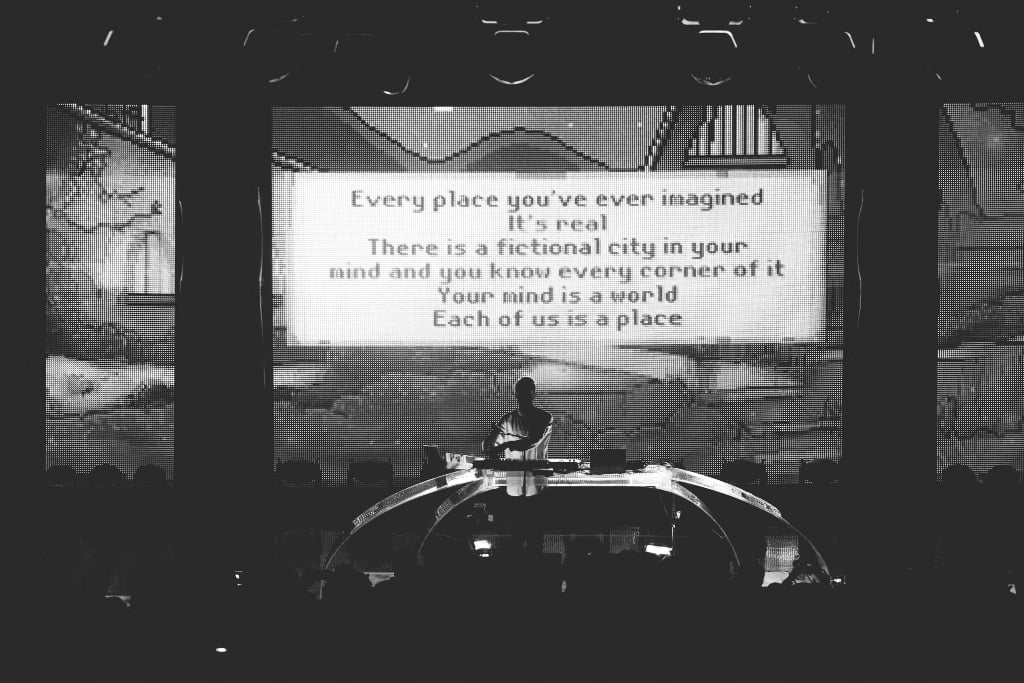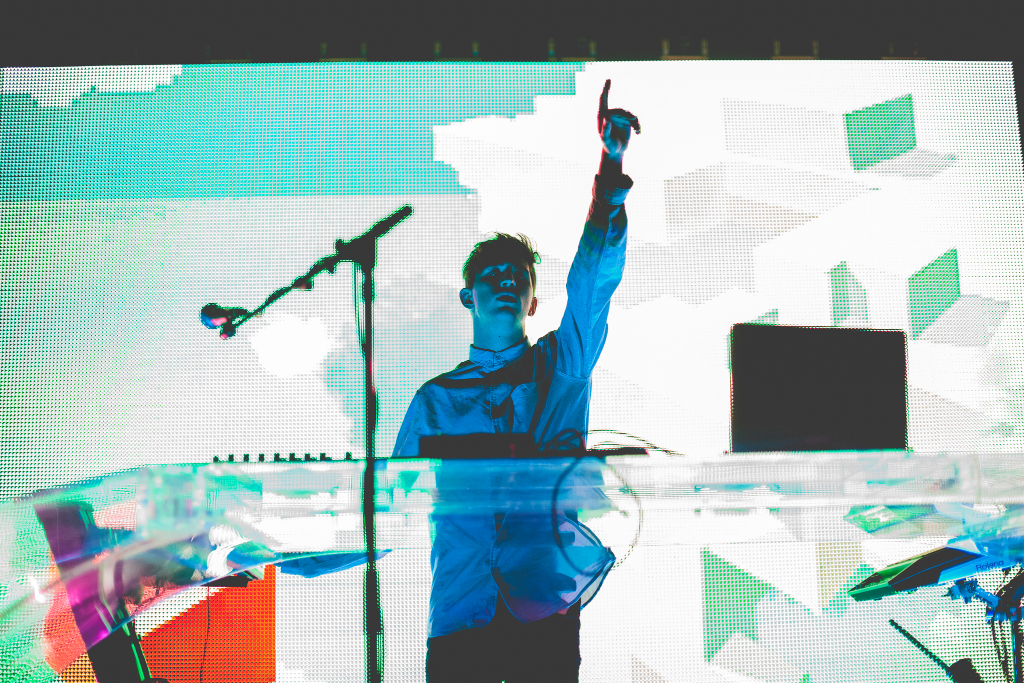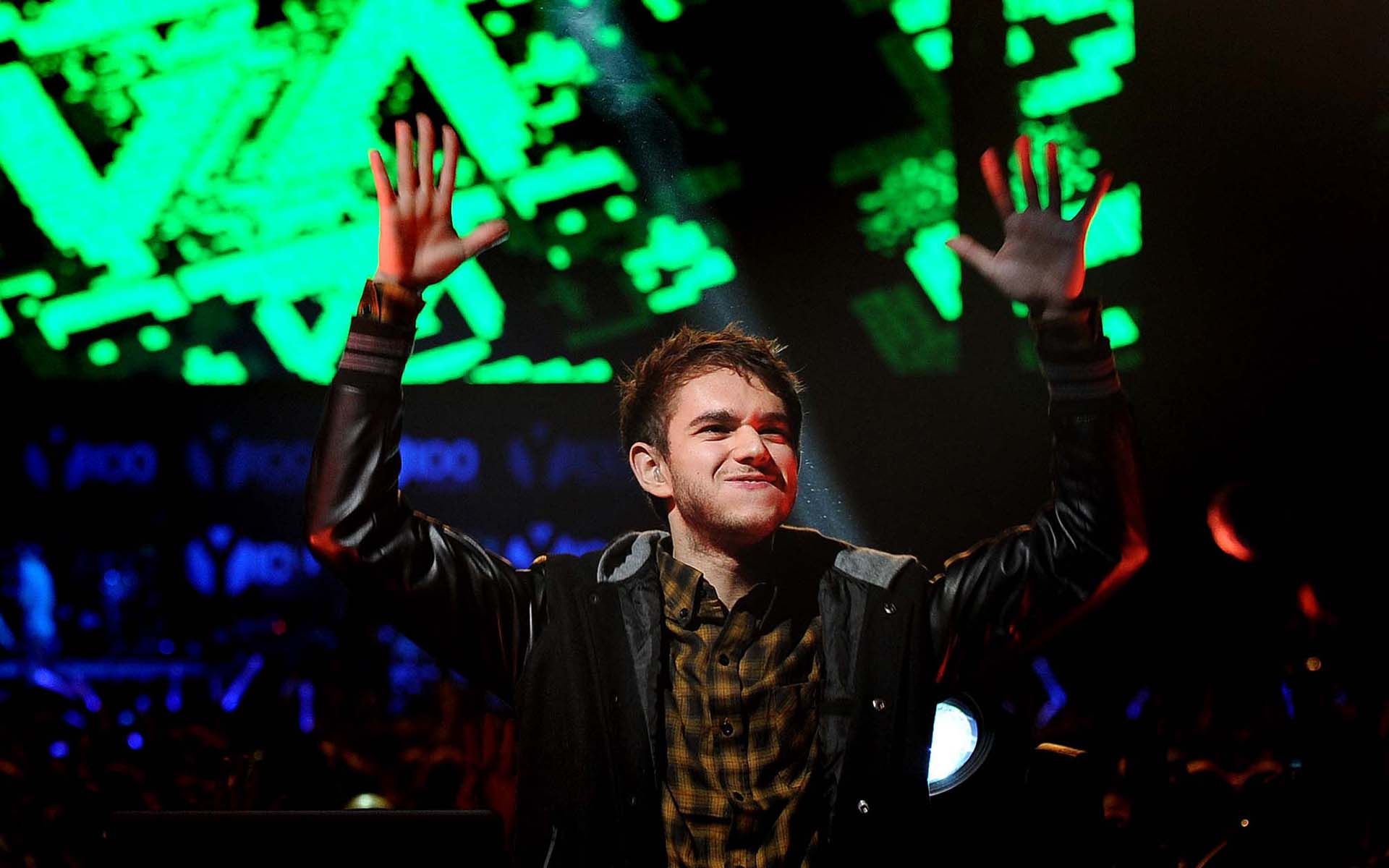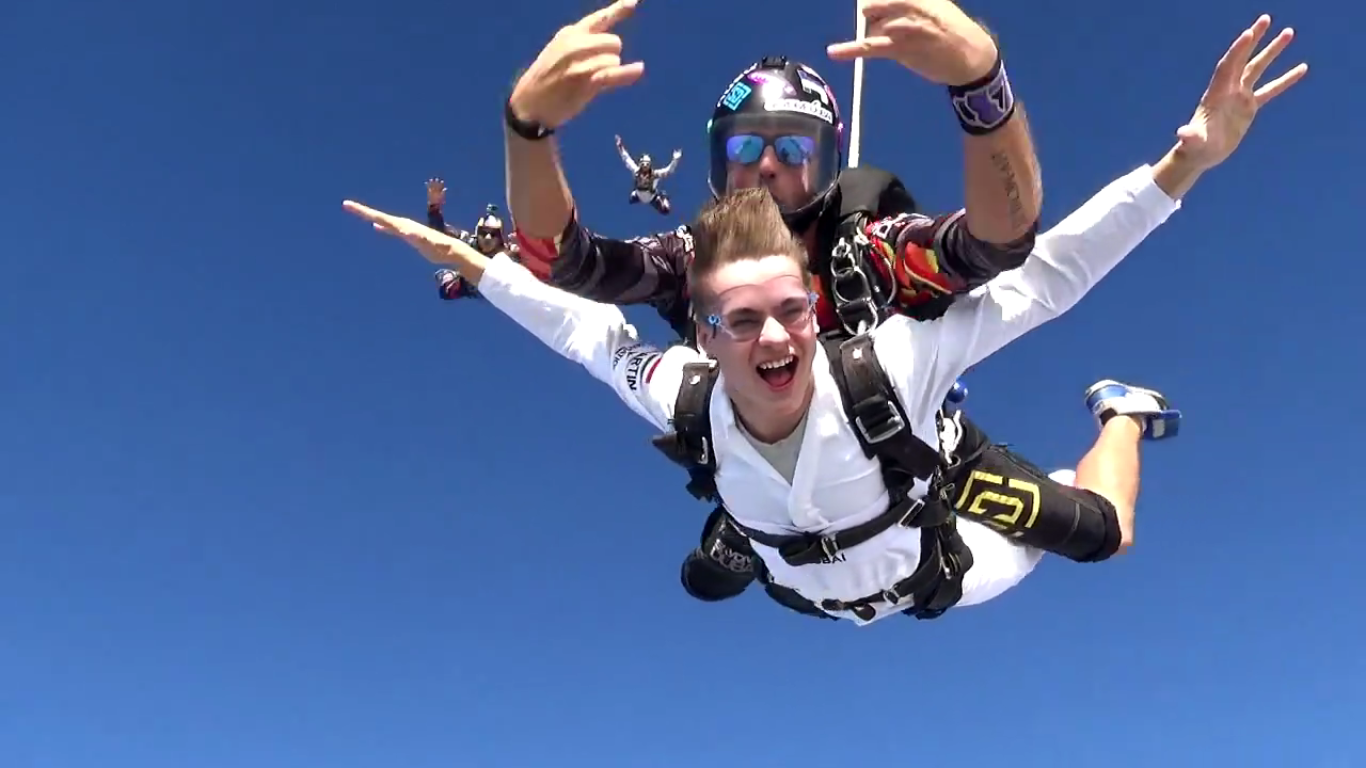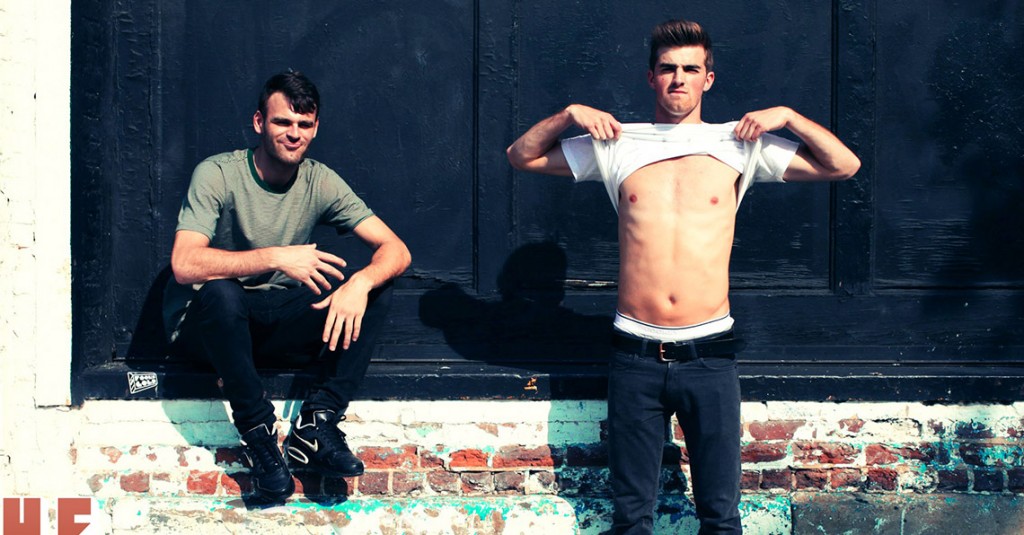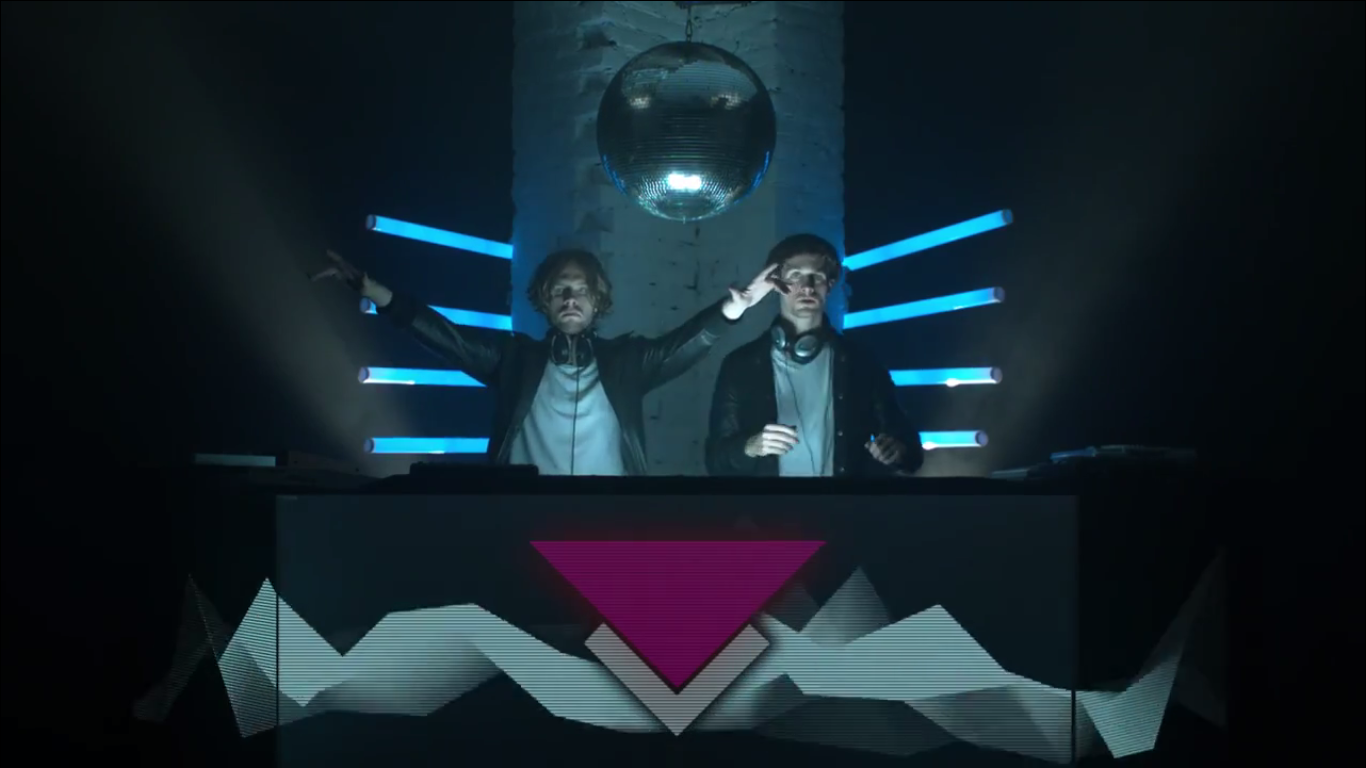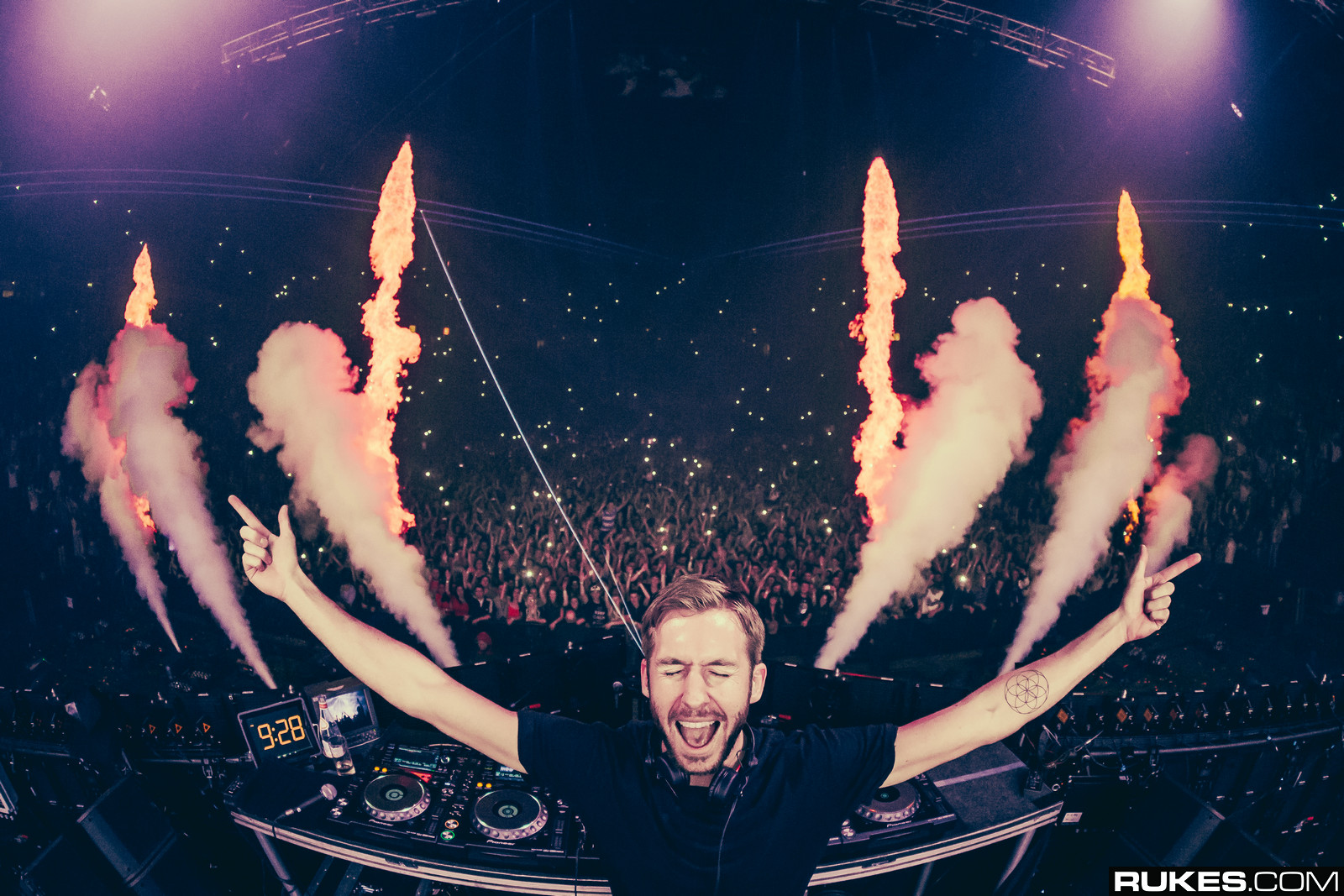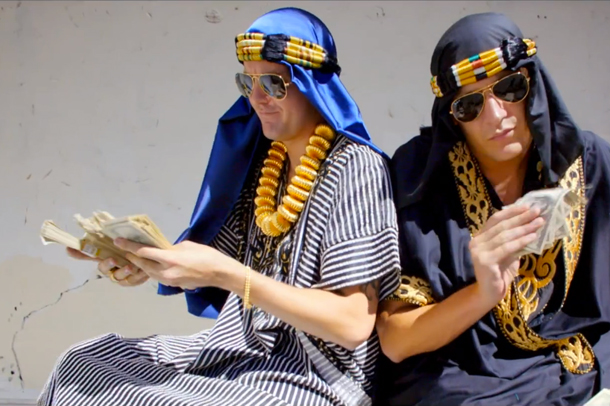The Canopy Club: a relatively small, intimate live setting in Urbana, IL (just a couple minutes’ walk from my dorm room at University of Illinois). Most will recognize it as the venue where Porter Robinson called out ragers at his show, but I remember it as the place where I experienced the Worlds live show and got to pick Porter’s mind following his performance.
I wanted to formulate questions that weren’t cliche or overdone, to really get an understanding of how Worlds came to be and the process behind it all. So after a 30-minute discussion with him, I decided it would be best to present his answers as-is, with no trimming or paraphrasing. If you’re a big Porter fan, you’ll appreciate his lengthy responses.
Could you walk through the process of creating the live experience? With the visual work with Ghostdad and the multitracks/triggering different parts.
The first thing I realized I needed to do was to organize my music sufficiently so that I could easily export those into multitracks. It started off with me trying to get my project files to a place where instruments were even in the same channels… I use FL Studio and I’m not respectful of “lanes” so I just throw kicks into random lanes. So I would say it was a two and a half month process of getting all the Worlds project files to a place where I had them exported into multitracks that, when combined, would perfectly recreate the original instrumental, because there were a few instances where there was one instrument that had somehow gotten into every [track]… It took me weeks and weeks of experimentation to find a method that would allow absolutely no crossover, where all the automation would be applied correctly so that when all the multitracks were combined it would be an exact replication of the original project. That was a two and a half month process, it was exhausting.
Meanwhile, I was making an effort to search for a company that could do hand-drawn animation so I could realize the ideas I had in my head for the visuals for the show. So these things were kind of going on concurrently.
This is kind of a long answer; I made two documents, one of them was a mood board, which was a collection of 200ish images that were all in the theme of Worlds, everything that felt like Worlds to me, and the second document was a style bible which was 18 pages of written instruction for every artist I work with, that includes the concept art, all the covers for the songs, all the music videos, and the tour visuals, so they were all referencing these two documents that I created. We sent these two documents to 7 companies who all specialize in creating tour visuals, and they all sent back motion demos, they sent back examples of what they thought I might want, and I went with a company called Imaginary Light Network, who seemed to best grasp the vision, and from there they would send, say, 50 hand-drawn ideas for something, be it a character or a landscape or an abstract idea, and I would approve some number of those and then I would give directions and say “this is wrong” or “this is too whatever”, and oftentimes I would just propose a completely unique idea and say, “let’s have a scene that looks like this”, I would describe it and take the reigns on it. The process of getting all those visuals made was I think a 4 or 5 month process and by the time they were finished, the only things that we really had were characters and backgrounds, so any of the looks you see in the show–well basically, we got an edit of the show, where we had that company cut the visuals to the music, and we used none of it. The edit was not correctly timed, it was too many full screen looks, it wasn’t minimal enough, there was too much overlap between the scenes. So then, we had that company export the visuals into alpha channels, which is characters, main moving elements, and backgrounds, and I flew out Ghostdad and he came to North Carolina with me and we spent 4 days dusk till dawn without ever leaving the house, editing video to music, and I’d say about 50% of the looks in the show came from just that, stuff where there’s two characters on each side of the screen and it’s black and there’s an abstract element in the middle. Anything that’s not just a completely illustrated look is something that we made during that time, so it was an exhaustive, exhaustive process.
Then, as far as the audio goes, once I got everything bounced into multitracks, I embarked upon the process of making new versions of each song for the show, editing and slicing, just trying to create more live-suitable versions of each song off Worlds. Then the idea was to export all of those and make sure that they were listenable, and get some semblance of the order of what it would be like, then I just used Ableton to bounce everything into multitracks so I could have the entire show, each song, separated into multitracks. And then I had some time left, and so what I did during that time was to go back into FL and make new versions of those multitracks that pulled out certain instruments and to make sampler instruments of whatever I wanted to be able to play. So a lead sound, I’d make a sampler instrument of that, and cut it out of the multitracks. This took forever, it was a massive, massive effort. The process of preparing Worlds [the tour] was one of the most difficult things I’ve ever done. It was like almost as much effort as the album condensed into a much, much shorter timeframe. So it was a monstrous, monstrous effort.
About the show visuals; if you could touch on your inspirations from art via Tumblr, and how “worlds” in video games have influenced the Worlds concept…
Yeah, I think it’s kind of related to what I was saying before, because a lot of those influences came through in the documents that I had prepared for these companies that I was going to work with, so I had a whole section on video-game-inspired imagery, and low-poly 3D, and stretched textures so that it would look like N64 graphics. I had a whole section on typical fuck-ups in game visuals, typical kinds of glitches… All that stuff was in the tour visuals, so that means that there were 6 entire companies who sent stuff to me that missed the mark, and one that seemed to understand. And I think that’s where a lot of the “getting stuff on track” came from, and making sure the influences were really reflected. Also, say they would send a visual of a group of friends walking around, I’d be like “OK, let’s make it underwater with a giant whale in the background and let’s have her stumbling across a bridge and there’ll be pixelly clouds in the background”, it was that sort of stuff; I was just sort of directing it, so that’s how I tried to get my own taste across. I also know that the company I was working with was referencing my blog a lot, they were aware of it and they were looking at it pretty often. There’s one part of the show where it goes into a video game UI, and I sent the main example of a user interface I thought would be a nice reference for the visuals, and so that’s what they did.
Do you view Worlds (the album and the live experience) as just one part of your overall creative vision, or is it an entire shift in your musical endeavors?
My prediction is that my next work will be more similar to Worlds than Worlds was to something like Spitfire. I think that Worlds is so deeply evocative of everything that’s influenced me in my whole life, that it feels like a center and I think I’m going to move with Worlds as a reference point; it feels like the beginning to me, Spitfire was only an EP. And I’m not ruling out making music in other styles, but I think that Porter Robinson music will be very much focused on those kinds of feelings for sure, I think that the idea of trying to change my style up again is just–I don’t know, but I want it to be progressive too, I don’t want my music to ever be too safe, just by the nature of my own tastes if it feels like Worlds 2 it’s not gonna come out and I’m not gonna be happy with it. But I think that a lot of the stuff that you feel on the record, those kinds of emotions, that type of chord progression and the notes I tend to go to and the style of the vocals, I think those are all things that are kind of deeply ingrained in my taste so I don’t know if there’s any escaping those things.
What, if anything, have you learned and applied from your early music to Worlds? There were some Worlds-like textures and ideas obviously before the album in Language, Easy, and even sort of in Spitfire.
Everything; I learned how to produce from my earlier works and that’s what’s most important in terms of being able to execute. I had the privilege of having enough eyes on me that I wanted to make sure my production finesse was top-notch, and then having a concept, an idea that I really wanted to embrace completely–I had the chops to do it, which was an asset for sure. Besides gaining an audience, which there’s no question my earlier material did, which is awesome and I owe it for that, the process of making music earlier just taught me how to produce and how to make stuff sound good and loud, and all that I still apply today.
My personal favorite piece from the album is Fellow Feeling, could you shed some light on the exact approach to writing it, between the whispered poetic phrases and the grungy drop that I believe you’ve said to be sort of tongue-in-cheek.
Fellow Feeling was a 3-project file endeavor that started with me just trying to use orchestral instrumentation. So much of my influence has come from movie scores, and from that type of instrumentation, it’s just important to me. So I tried to write something that was kind of in that vein, and then the project file got so full that I couldn’t write anything else; all that orchestral instrumentation was so CPU-intensive that I had to start a 2nd project file to continue the song. And that’s what I think enabled such a jarring shift in tone… I was using a sample from the show Firefly, there’s a character named Saffron and I always thought her voice had an interesting timbre, so I sampled her voice a lot, and it seemed to kind of convey this message. But I wasn’t able to get the rights to those words or to her voice without paying an exorbitant fee so I worked with this YouTube anime voice actress/cover song artist named Amanda Lee and we worked together to create the final–I chose the phrasing and she spoke it, she gave me several takes. And then yeah the last section, which is the more kind of Language/Easy-ish drop thing, I think the song [Fellow Feeling] is really self-referential and it’s a reflection, and so much of the album is about fiction and escapism and fantasy and it’s about stories, and I think of this song as pretty much the only one on the album that has anything to do with reality and it’s very much a take on the music scene. But then again, I don’t know if I can really say that that aggro part is really tongue-in-cheek, because I think it sounds cool, and it doesn’t sound like those insufferable “how to make big room house” tutorials, they never sound as good as the real thing. My god, that’s the dumbest snark shit in the world, when I see people say “making big room house is so easy” and then it never sounds as good as the actual thing. Even though big room house sucks, I wasn’t trying to do this thing that was necessarily a satire of EDM or whatever, because I think that would just sound wicked corny; I wanted to do something that was heavy and aggro and draw this contrast against the very pretty instrumentation, and I feel like it made the pretty parts prettier, so that was really my take.
Do you feel it was more difficult to write and produce Worlds compared to your early works? Was it a matter of just changing your perspective on the creative process, or learning a whole new style and sound?
I don’t think I was learning a new sound, with songs like Flicker or Sad Machine or Divinity I wasn’t referencing much with that material, it was coming out of me in my mind, and the idea of doing something that’s like 90 BPM and loud but also focuses on being beautiful, I had never heard anything like that in my life. I was kind of teaching myself–Divinity was the first song in that style that I wrote, and when I wrote it I was like “this is the sound that I’m gonna embrace for this record”. And I think I got better at it in some ways, but I also think that it’s hard to match that raw first inspiration as well, but there was never a part where I was like–I think that production can be so challenging if you’re trying to copy something, but when I was just trying to do–I was doing this thing where in my mind I was trying to reject stuff that I felt was too derivative… That was a really liberating way to write music because I didn’t have to reference anything else, and I was writing what felt good.
Now talking about the album and the process of unveiling it; did you have a “strategy” behind introducing it to your fans who weren’t necessarily conditioned to something like Sea of Voices (which got a lot of mixed reactions at first)? And what was your thought process behind choosing which songs would best represent the album as lead singles?
I wanted to do something that was really jarring at first… People at the label wanted to do this bonus track called Shepherdess, which is the most EDM thing I think I did in the last 3 years, they said “we should start with this” and I wanted to do the exact opposite and do the song that was the least accessible to dance fans, so that bare minimum they’ll notice it, think about it and talk about it. I mean, if it was something safe think about how disappointing that would be. I still wanted to release Shepherdess in the end because I liked the breaks and I think that it’s pretty and I always considered it part of Worlds, even though it has this heavy bit. But I don’t really like to think too much in terms of strategy, I mean I think all that stuff is necessary, but the word “marketing” makes me want to throw up and I would much, much rather just put my music out but I also recognize it as this necessary thing. So I guess that strategically it made sense for me to lead with something that was unexpected, just to bare minimum inspire some conversation a little bit. And then the next song that was due to come out was Flicker, but then I wrote Sad Machine which was the last song written for the album, and I caused freakin’ mayhem at the label; 3 days before it was supposed to come out I changed the song that we were releasing, which you wouldn’t expect but it is a fucking nightmare to get something like that done, but I just knew that Sad Machine needed to be the next one that was put out. Lionhearted, I guess the label felt had potential at radio, and I was game to let them try it, and with Flicker, I just wanted to show a slightly cuter side to the record. I don’t know, I think that it’s necessary to kind of stoke interest in what you’re doing, and I think that if I had just dropped the whole record all at once I wouldn’t have caught the attention of people who are interested in the more left-leaning side of electronic music; I think it’s kind of a necessary evil to lead with stuff and Sea of Voices was a sensible choice in that way.
Yeah, and I remember that on Twitter you had said that one day you just wanted to make SOV public on Soundcloud…
Yeah, I mean I think the conventional label wisdom would be like “let’s do a fucking hashtag campaign and put a release date and make a teaser video” and do 99 things to make sure that this captures people’s attention, but in my opinion that stuff actually turns people off and it makes people disconnect, especially the sort of people that I want to reach with my music. I don’t know, when I see people uploading teaser-y stuff and it seems like their management posted it I just couldn’t be less interested… My guess was that if I just put something up unexpectedly that it would interest people, and it did. I feel like I understand the Internet pretty well; I was born and raised on the Internet and I never like–I had to take my girlfriend around Chapel Hill recently just to show her what it was like, and I was like, I actually don’t know my own hometown very well because I was just raised on the computer. And so without ever trying to get too cynical or calculating, I think I have a pretty good grasp on what makes stuff on the Internet tick… And yeah, I think it helps, but I just try to never get too marketing-y, and I definitely shoot myself in the foot sometimes by, there’s stuff that strategically would help like if I was willing to do more sponsorships or do more TV placements or anything like that, I’m very reluctant to do that sort of thing. And it’s this sort of mixed bag, because I think that I know how to get people interested online, but I don’t know how to reach the common person in some ways.
Have you been working on music while on tour thus far, or have you been mostly focusing your energy on keeping up the current shows?
It’s definitely been a big effort getting the tour stuff right even while I’m on tour, it’s changed considerably, but I’ve also been writing a little bit of music… but I don’t know if I’m quite ready to say anything about what I’m writing, really. But yeah I’ve been writing music.
Last question, what in your mind is next after Worlds? More DJ sets, or continuing the more live experience i.e. Worlds? And do you possibly have any plans on starting a sort of curated record label in your name?
I’ll say these things, because I have some secret stuff up my sleeves. I’ve been paying a lot of attention to what’s happening in music right now, and I listen diligently to every new thing that gets released and I’m collecting music, and I definitely plan to bring the Worlds tour (only originals) to every place that I can, but that doesn’t mean that DJ sets are permanently off the table. I don’t know that I’d necessarily have a record label, but I’m definitely working on some interesting, interesting stuff and I’m definitely paying a lot of attention to what’s happening in music right now. I make a point of spend at least an hour and a half a day listening to every single new thing that came out and digging super deep, and I think that’s a habit I carried over from DJing, because when I DJed electro I always wanted to have cuts that were really shocking and unexpected but also worked without being this massive cliche; my obsession was finding songs that would make you go “what was that”, and I think that’s a habit I’ve carried over. I’m still constantly looking for new stuff and I’m scared of losing touch with everything that’s happening, and that means that I’m looking into both crazy obscure Japanese netlabel stuff and drumcode, but I’m also still listening to whatever it is that your top 100 guys are putting out too. I just like to have my finger on the pulse and stuff… I’m keeping track of everything, I’m “scheming”.
Photography by Taylor Rambo
Follow Porter Robinson:
Facebook
Twitter
Soundcloud

